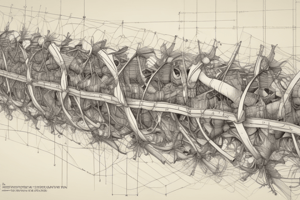Podcast
Questions and Answers
What type of diagram is used to visualize algorithms and programming logic?
What type of diagram is used to visualize algorithms and programming logic?
- Nassi-Schneiderman Diagrams (correct)
- ERDs
- Block Diagrams
- Flowcharts
What is the primary purpose of using Entity-Relationship Diagrams (ERDs)?
What is the primary purpose of using Entity-Relationship Diagrams (ERDs)?
- To design software architecture
- To visualize algorithms
- To represent entities, attributes, and relationships (correct)
- To model business processes
What is the benefit of using Structural Analysis Diagrams in system design?
What is the benefit of using Structural Analysis Diagrams in system design?
- To improve communication among stakeholders
- To reduce system complexity
- To increase system complexity
- To support informed design decisions and system optimization (correct)
What is the primary purpose of Block Diagrams?
What is the primary purpose of Block Diagrams?
What is the purpose of using Unified Modeling Language (UML) notation?
What is the purpose of using Unified Modeling Language (UML) notation?
Study Notes
Types of Structural Analysis Diagrams
- Block Diagrams: Represent systems as interconnected blocks, showing inputs, processes, and outputs.
- Flowcharts: Illustrate step-by-step procedures, decision-making processes, and logic flows.
- Nassi-Schneiderman Diagrams: Visualize algorithms and programming logic using a sequence of connected boxes.
Elements of Structural Analysis Diagrams
- Entities: Objects or concepts being modeled, represented as boxes or rectangles.
- Attributes: Characteristics or properties of entities, listed inside entity boxes.
- Relationships: Connections between entities, represented by lines or arrows.
Notations and Symbols
- Unified Modeling Language (UML): Standard notation for software design and modeling.
- Entity-Relationship Diagrams (ERDs): Use rectangles, diamonds, and lines to represent entities, attributes, and relationships.
- BPMN (Business Process Model and Notation): Standard for business process modeling and workflow representation.
Purposes of Structural Analysis Diagrams
- Communication: Simplify complex systems and facilitate understanding among stakeholders.
- Analysis: Break down systems into manageable components for analysis and improvement.
- Design: Visualize and plan system architectures, software designs, and business processes.
Benefits of Structural Analysis Diagrams
- Improved understanding: Clarify complex systems and relationships.
- Enhanced communication: Facilitate stakeholder understanding and collaboration.
- Better design: Support informed design decisions and system optimization.
Types of Structural Analysis Diagrams
- Block Diagrams represent systems as interconnected blocks, showing inputs, processes, and outputs.
- Flowcharts illustrate step-by-step procedures, decision-making processes, and logic flows.
- Nassi-Schneiderman Diagrams visualize algorithms and programming logic using a sequence of connected boxes.
Elements of Structural Analysis Diagrams
- Entities are objects or concepts being modeled, represented as boxes or rectangles.
- Attributes are characteristics or properties of entities, listed inside entity boxes.
- Relationships are connections between entities, represented by lines or arrows.
Notations and Symbols
- Unified Modeling Language (UML) is a standard notation for software design and modeling.
- Entity-Relationship Diagrams (ERDs) use rectangles, diamonds, and lines to represent entities, attributes, and relationships.
- BPMN (Business Process Model and Notation) is a standard for business process modeling and workflow representation.
Purposes of Structural Analysis Diagrams
- Communication: simplify complex systems and facilitate understanding among stakeholders.
- Analysis: break down systems into manageable components for analysis and improvement.
- Design: visualize and plan system architectures, software designs, and business processes.
Benefits of Structural Analysis Diagrams
- Improved understanding: clarify complex systems and relationships.
- Enhanced communication: facilitate stakeholder understanding and collaboration.
- Better design: support informed design decisions and system optimization.
Studying That Suits You
Use AI to generate personalized quizzes and flashcards to suit your learning preferences.
Description
This quiz covers the different types of structural analysis diagrams, including block diagrams, flowcharts, and Nassi-Schneiderman diagrams, as well as their elements, such as entities, and their applications in system modeling and programming.





